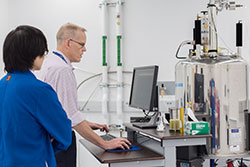
 Looking at molecules just got easier for UC Merced researchers, now that Professor Erik Menke, Professor Jason Hein and other colleagues have opened a nuclear magnetic resonance (NMR) lab.
Looking at molecules just got easier for UC Merced researchers, now that Professor Erik Menke, Professor Jason Hein and other colleagues have opened a nuclear magnetic resonance (NMR) lab.
“It’s a standard piece of equipment — nothing out of the ordinary — but it’s exceedingly important that we have it,” Hein said. “We had it installed in Science and Engineering Building 2 so it’s accessible to the whole campus.”
The campus had an old NMR instrument at the Castle Commerce Center, but it badly needed updating, Hein said.
Most research universities have several NMR instruments to meet various needs, such as biochemical investigations, small molecule research and material chemistry development.
NMR allows researchers to characterize individual molecules because the nuclei in a magnetic field absorb and re-emit electromagnetic radiation.
“It tells you about a molecule’s structure and allows you to study chemicals at the molecular level,” Hein said.
But finding funding for such fundamental equipment proved difficult, Hein said.
He and Menke led a collaborative effort, combining funds from the U.S. Army, the UC Merced Office of Research and School of Natural Sciences Dean Juan Meza to reach $500,000. Adding that to another donation of equipment and supplies from Agilent Technologies worth $450,000 allowed the group to buy a brand new 500 MHz instrument and update the existing 400 MHz system.
The NMR’s installation this winter was a complex project that included bringing it in piece by piece — including a new superconducting magnet and cooling equipment — and then it had to be calibrated.
Hein said the lab will have an open house this spring to give the NMR its public debut. In the meantime, the campus has already hired a facility manager, Dave Russell, whom Hein said is a highly trained NMR specialist. Russell will conduct his own research in the facility, and can develop research experiments with interested researchers and teach students how to use the equipment.
“While this may be a fairly routine NMR system as these instruments go, the combination of purchasing the right technology and having Dave to manage it has made this a stellar user facility,” Hein said. “Anyone looking to use NMR in their research programs will be stunned by our capability and ease of use.”
As a chemist, Hein can use the NMR to confirm that he has made the molecules he intended to make. But its applications are countless, he said, including for students, who should have access to the equipment as a basic part of their research training. Russell is also looking to set up remote teaching and research partnerships with local California State University campuses to allow them access to the facility, as well.
“Having this teaching and research infrastructure is critical for our graduate and undergraduate students, but with some creative setup, we should be able to enhance the research capacity of the entire Central Valley higher education community,” Hein said.
Lorena Anderson

Senior Writer and Public Information Representative
Office: (209) 228-4406
Mobile: (209) 201-6255






